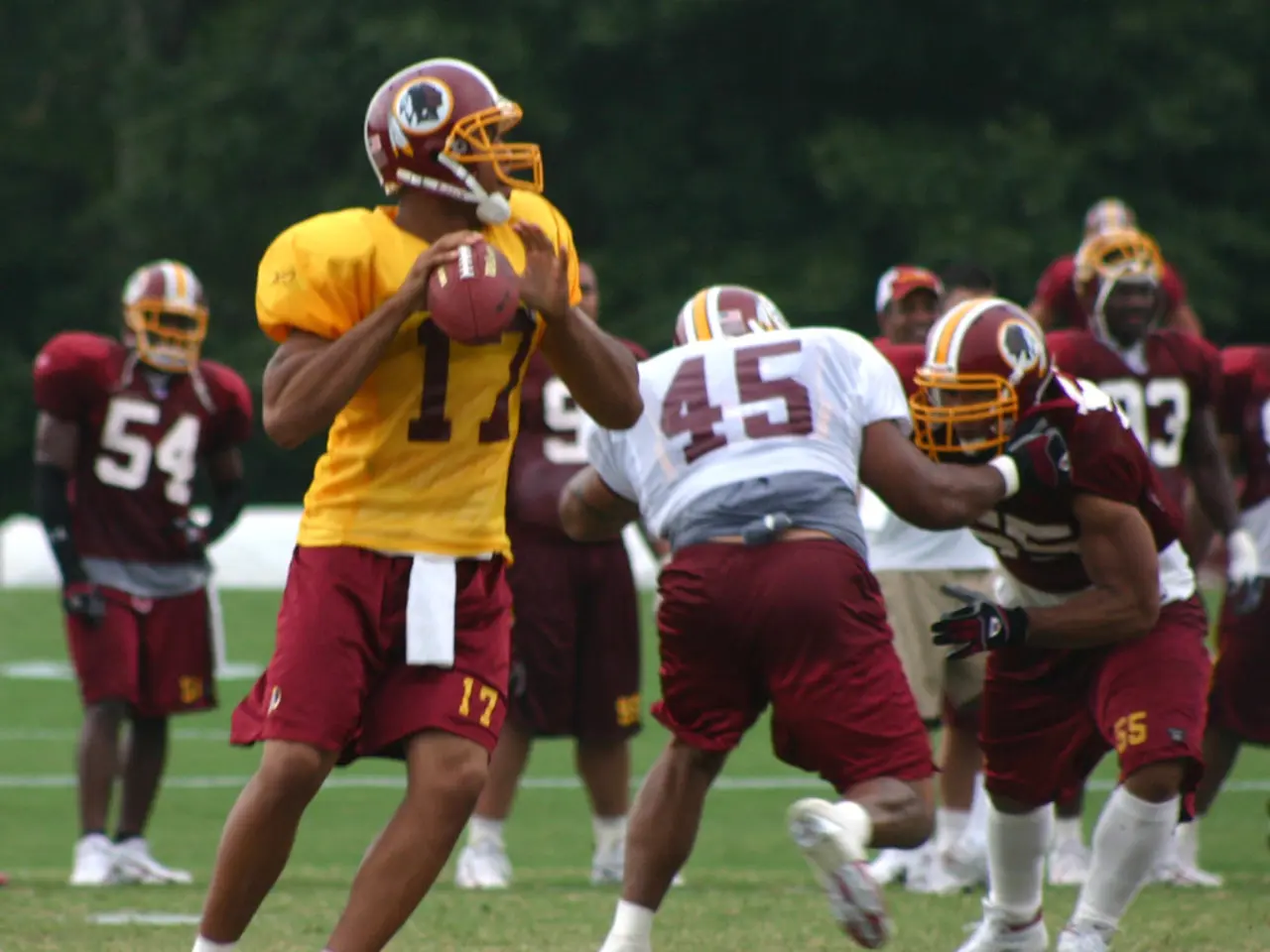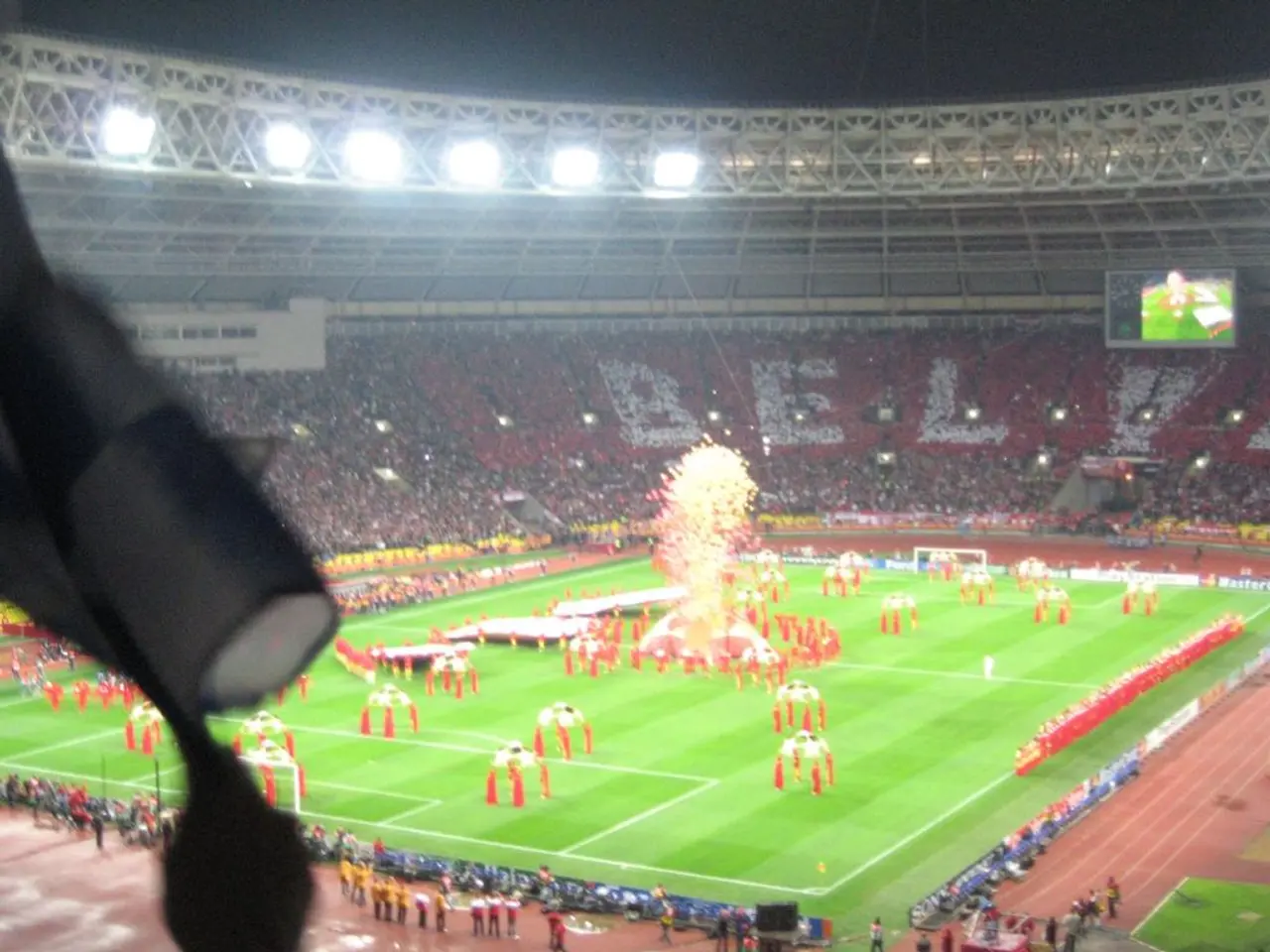The Fundamentals of American Football Explained
=========================================================
In the thrilling world of American football, the National Football League (NFL) stands as the pinnacle of the sport. Here's a breakdown of the essential elements, rules, and procedures that make up an NFL game.
The Field
An NFL football field is a rectangle measuring 120 yards long and 53.3 yards wide. It features goal lines, end zones, yard lines every 5 yards, and hash marks to aid in play alignment. The goal posts are positioned at the back of each end zone, with a crossbar 10 feet above the ground and uprights extending at least 10 feet high.
Key Features and Their Functions
- Field Dimensions: The playing area includes two 10-yard end zones for scoring [1].
- End Zones: These are the 10-yard-deep areas where touchdowns are scored [1].
- Goal Lines: These marks the start of the end zone and where a touchdown is scored upon crossing [1][3].
- Yard Lines: These mark every 5 yards; numbers every 10, helping teams and officials track field position [1][5].
- Hash Marks: Positioned about 70 feet 9 inches from sidelines to align the ball for various plays, ensuring consistent placement and fairness [1].
- Goal Posts: These are used for field goals and extra points; their height and width are standardized for scoring consistency [1].
- Field Markings: Lines must be precise and durable, painted white for visibility, with alternative colors (blue/orange) used in snow for clarity [3].
Additional Elements
- Playing surface: Either natural grass, artificial turf, or hybrid surfaces, with decisions influenced by maintenance and playing conditions [1].
- Lighting: Stadium-quality floodlights enable night play [1].
Game Procedures
An NFL game is divided into four quarters, each 15 minutes long, with an extended halftime break between quarters two and three. If the teams are tied after four quarters, they play an additional overtime period of 15 minutes. The first team to score in the overtime wins.
Scoring a Touchdown
A touchdown is awarded when any part of the ball reaches the edge of the goal line, which is the one a team is advancing toward [2].
Challenging an Official's Call
A coach can challenge an official's call by tossing a red flag on the field [4]. If a team wins the challenge, it retains its time-out, and the official's call is overruled. However, if a team loses the challenge, it loses a time-out, and the official's call stands. When a play is challenged, the referee has 90 seconds to review the play. Challenges can be made before the next play begins but cannot occur in the last two minutes of each half.
Punting the Ball
The defensive team stops the offensive team from getting 10 yards in three downs, and the offensive team free-kicks, or punts, the ball to the other team on third down [6]. The kicking team is hoping to kick the ball down the field and tackle the receiving team's kick returner before he comes back down the field (punt coverage).
Scoring a Safety
If a player is tackled in his own end zone, meaning the end zone his team is defending, the other team gets the ball though a free kick [7].
Time Management
Teams can stop the clock by running out of bounds, throwing an incomplete pass, or calling a time-out, of which they have three per half. Time also stops for each of the two-minute warnings, observed two minutes prior to the end of the second and fourth quarters.
Recovering the Ball
A team recovers a ball dropped by the other team (fumble) or picks off a ball thrown by the other team's quarterback (interception).
Officials and Their Roles
- Referee: The head official on the field and is responsible for giving signals and serving as the final authority on rule interpretation [2].
- Umpire: Rules on players' equipment and conduct and takes a position about five yards behind the line of scrimmage [8].
- Head Linesman: Calls infractions of player movement when lined up on the line of scrimmage and keeps track of the downs and manages the chain crew [9].
- Line Judge: Keeps time during the game to backup the official clock operator and backs up the head linesman on line-of-scrimmage calls [10].
- Field Judge: Makes calls regarding the wide receivers and backs on his side of the field and watches the defensive players that the back is blocking [11].
- Side Judge: Makes calls regarding the wide receivers and backs on his side of the field and watches the defensive players the back is blocking [12].
- Back Judge: Makes calls regarding the tight end and the player the tight end might be blocking and is responsible for keeping the time for the 25-second play clock, time-outs, and intermissions [13].
- Replay Assistant: Can also initiate a review in the last two minutes of each half and in the overtime period [14].
Extra Points and Two-Point Conversions
After scoring a touchdown, a team can kick a field goal for an extra point or attempt to run or pass the ball into the end zone for a two-point conversion [15].
Turnovers on Downs
The offensive team fails to advance the ball 10 yards after three downs and may choose to punt the ball to the other team [16]. If a team fails to gain 10 yards after four downs and has to surrender the ball to the other team if it doesn't punt.
Punt Returns
The receiving team can return a punt, meaning it can catch and run it back down the field [17].
[1] NFL Rulebook: https://operations.nfl.com/the-rules/2022-nfl-rulebook/ [2] Referee: https://www.nfl.com/referees/ [3] Field markings: https://en.wikipedia.org/wiki/American_football_field_markings [4] Challenge: https://www.nfl.com/rules-and-regulations/challenges [5] Yard lines: https://www.nfl.com/rules-and-regulations/yard-lines [6] Punt: https://www.nfl.com/rules-and-regulations/punting [7] Safety: https://www.nfl.com/rules-and-regulations/safety [8] Umpire: https://www.nfl.com/referees/umpire [9] Head linesman: https://www.nfl.com/referees/head-linesman [10] Line Judge: https://www.nfl.com/referees/line-judge [11] Field Judge: https://www.nfl.com/referees/field-judge [12] Side Judge: https://www.nfl.com/referees/side-judge [13] Back Judge: https://www.nfl.com/referees/back-judge [14] Replay Assistant: https://www.nfl.com/referees/replay-assistant [15] Extra point, two-point conversion: https://www.nfl.com/rules-and-regulations/extra-point-two-point-conversion [16] Turnover on downs: https://www.nfl.com/rules-and-regulations/turnover-on-downs [17] Punt return: https://www.nfl.com/rules-and-regulations/punt-return
In the world of American football, the National Football League (NFL) is the league where football, a type of sports, is played at its highest level. This American-football league has a unique culture and game rules that make it both challenging and entertaining.
After scoring a touchdown in an NFL game, teams can choose to attempt an extra point by kicking the ball through the goal posts or attempt a two-point conversion by running or passing the ball into the end zone.






